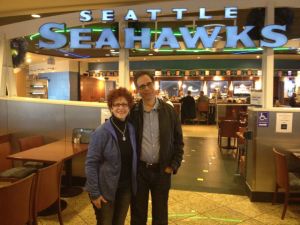
by Diane Masson | Mar 2, 2015

Diane and Chris Flying 1000 Miles to Look for Affordable Memory Care for my Mother-in-law
My mother-in-law is currently in a secured memory care community. The price is very high – $6750 for 30 days of respite care. If we don’t move her within two weeks, the community fee for a permanent stay will be $10,000 and her monthly fee will be $9,000 a month. Are you kidding me? Who can afford this?
She was living in her own home six weeks ago, but a crisis you can read about HERE has left her adult children scrambling to find a permanent solution for my mother-in-law.
My husband, Chris, and I work in the senior housing profession, so who is better than us to evaluate the choices. We flew 1000 miles yesterday to be the experts on the ground in Seattle. We are going to visit three memory care communities today and one or two tomorrow. The best way to evaluate and compare retirement communities is in a short span of time. The crème always rises to the top.
We can’t base our decision on what the community looks like, the size of the rooms or the wonderful sales person. We are going to dig deeper and ask the following questions of each memory care community:
- What is the staff turnover? We want to see longevity of staff – particularly in the administrator, nurse, caregivers and possibly the chef.
- Do the staff and residents look happy? We will talk to some of each.
- What will be my mother-in-laws quality of life? What programming is offered? How often does live entertainment come in the building? How will they minimize her anxiety?
- How many hours does the nurse work per day? Twenty-four hours will always be the best answer, but you get what you pay for.
- What is the procedure if my mother-in-law falls? When my mom was in an assisted living community with dementia, every fall led to a terrifying emergency room (ER) visit that was stressful for her. If a nurse is on shift around the clock, it may save my mother-in-law from this stress. If the fall happens at 2:00 am and only a caregiver is on staff, the call to 911 will almost always lead to the terrifying ER visit.
- Do doctors come and visit my mother-in-law here or does she have to be driven to her doctor? Who will do that? Will someone accompany her? What are the costs?
- We will discuss my mother-in-law’s dietary needs and meet the chef. When my mother-in-law was in the hospital, she became incontinent. We hope it is not permanent and assume the diarrhea was from feeding her too many raw vegetables and fruit. She has not eaten those in years because of too much radiation after colon cancer. So it is important that we advocate for her in this regard. Just incontinence can cost an additional $1,000 a month.
- What is the initial community fee? What is the current monthly cost for room, board and care? What is the maximum cost it could potentially be? What are the additional costs? What have we not asked that could cost extra? What happens when someone is broke and can’t pay these hefty fees? We need to find out if the memory care community charges for my mother-in-law’s care by points, levels of care, or is all-inclusive. Pricing can be very grey and it is easy to be confused. Even us experts will have to see beyond the sales “smoke and mirror” answers.
- What is the history of their year over year monthly increases? We can’t just look at affordable costs today, but what if my mother-in-law lives for years?
- Is the room furnished? Do we just bring personal affects? Do we need to go buy a twin bed, TV or special chair?
- How do they handle hearing aids and glasses? My mother-in-law has two hearing aids that she has not used in six weeks.
- What is their procedure in contacting the family to give updates or let us know of a change in our loved one’s health?
- Is there anything that we should have asked but did not?
We will look at the entire memory care community space, her possible room and the outside walking area. I will keep you posted on our family evaluation and pricing for these communities. Hopefully, sharing my experiences and tips can help you too.
Diane Masson’s new guide book for seniors, “Your Senior Housing Options,” will be available next week on Amazon.com. If you sign up for my weekly newsletter on the right side of this blog, you will be notified when this valuable resource can be purchased. Check out my new website: Tips2Seniors.com or please follow me on Facebook.
Diane Twohy Masson is the author of “Senior Housing Marketing – How to Increase Your Occupancy and Stay Full,” available at Amazon.com with a 5-star rating. The book is required reading at George Mason University as a part of its marketing curriculum. Within this book, the author developed a sales & marketing method with 12 keys to help senior living providers increase their occupancy. Masson developed this expertise as a marketing consultant, sought-after blogger for senior housing and a regional marketing director of continuing care retirement communities in several markets. She has also been a corporate director of sales and a mystery shopper for independent living, assisted living, memory care and skilled care nursing communities in multiple states. Currently, Masson is setting move-in records as the regional marketing director of two debt-free Continuing Care Retirement Communities in Southern California – Freedom Village in Lake Forest and The Village in Hemet, California. Interestingly, this career started when she was looking for a place for her own mom and helped her loved one transition through three levels of care.
© Marketing 2 Seniors| Diane Twohy Masson 2015 All Rights Reserved. No part of this blog post may be reproduced, copied, modified or adapted, without the prior written consent of the author, unless otherwise indicated for stand-alone materials. You may share this website and or it’s content by any of the following means: 1. Using any of the share icons at the bottom of each page. 2. Providing a back-link or the URL of the content you wish to disseminate. 3. You may quote extracts from the website with attribution to Diane Masson CASP and link https://www.marketing2seniors.net For any other mode of sharing, please contact the author Diane Masson.

by Diane Masson | Aug 4, 2013
 As a daughter with a mom in skilled nursing care, the PBS documentary entitled “Life and Death in Assisted Living” really upset me. My mom has vascular dementia and I have been her advocate for the last 7 years in assisted living. Those of you who follow my blog know that I moved my mom 1000 miles into a skilled nursing care near me – about 10 weeks ago. This transition happened because I was 100% in tune with my mom’s needs.
As a daughter with a mom in skilled nursing care, the PBS documentary entitled “Life and Death in Assisted Living” really upset me. My mom has vascular dementia and I have been her advocate for the last 7 years in assisted living. Those of you who follow my blog know that I moved my mom 1000 miles into a skilled nursing care near me – about 10 weeks ago. This transition happened because I was 100% in tune with my mom’s needs.
We all know someone who had a horror story during a hospital stay. Last week one of my colleagues was shocked to walk in and find her dad in soft restraints after heart surgery. He was 82 and not coming out of the anesthesia well. The nurse said that she did not have enough staff to help him, so she had to use soft arm restraints. My colleague asked if they could please remove the restraints. She and her mom each took one arm of her dad and literally held him thrashing around all night with no sleep.
Every senior or human being needs an advocate to make sure that the care they are paying thousands of dollar per month in any level of care is being provided. Trying to be a good advocate for my mom and living two states away – just about killed me. You have to have eyes on your loved one or pay someone to come in and be your eyes – particularly when they have dementia.
When a senior has dementia, like my mom, they get to the point where they cannot communicate all their needs, pains or desires to either caregivers or family members. There needs to be an advocate who truly knows that person and can look for and understand his or her unspoken needs on a regular basis.
If my colleague had not shown up to be an advocate for her dad, he would have been in soft restraints all night. If I had not flown in every few months to see my mom with my own eyes, areas of concern would not have been addressed. My mom had good care in assisted living with a caring staff, but she is my mom and I know her best.
It always makes me sad when a future senior resident considering senior housing has no family or only distant relatives. They may ask a lawyer or a niece in Canada to become their advocate or power of attorney. Will this remote person advocate properly on his or her behalf – if the senior can no longer communicate verbally?
There are great senior housing options available with loving caring staff, but it is always wise to have an advocate that knows your unspoken needs when you can no longer speak on your own behalf.
Tip: Future residents and their family members need to do their homework as they explore all senior housing options including assisted living. Always ask what the longevity of staff is at each retirement community, assisted living, memory care or skilled care nursing that you are considering for yourself or a loved one. Staff turnover is an indicator of an underlying management or ownership problem in all levels of senior care. Look for communities with longevity of staff.
Diane Twohy Masson is the best-selling author of “Senior Housing Marketing – How to Increase Your Occupancy and Stay Full,” available at Amazon.com with a 5-star rating. The book is required reading at George Mason University as a part of its marketing curriculum. Within this book, the author developed a sales & marketing method with 12 keys to help senior living providers increase their occupancy. Masson developed this expertise as a marketing consultant, sought-after blogger for senior housing and a regional marketing director of continuing care retirement communities in several markets. She has also been a corporate director of sales and a mystery shopper for independent living, assisted living, memory care and skilled care nursing communities in multiple states. Most recently Masson was recruited to consult for two debt-free Continuing Care Retirement Communities in Southern California – Freedom Village in Lake Forest and The Village in Hemet, California. Interestingly, this career started when she was looking for a place for her own mom and helped her loved one transition through three levels of care.

by Diane Masson | Feb 9, 2013

 It only takes 15 minutes or less per day to engage in social media! Has your retirement community entered the twenty first century with social media yet?
It only takes 15 minutes or less per day to engage in social media! Has your retirement community entered the twenty first century with social media yet?
Some of the larger senior housing organizations have wonderful social media programs. Sunrise Senior Living posts great blog content multiple times a week. Emeritus sends out engaging monthly email blasts. Other organizations with a nationwide presence have a staff who are dedicated to social media.
What do you do if you are a stand along retirement community or only have a handful of senior living communities in your portfolio? You can still do social media for 15 minutes a day. Seriously – I am doing it at two Continuing Care Retirement Communities (CCRCs) in Southern California.
First, you can either set up some social media yourself or have it professionally done for about $1000 per community. I had mine set up professionally. Then I trained one person at each CCRC to add content. At first it took them some time to get into the swing of it, but now they can create three or four posts at time and then schedule one post to be released online at a time – one per day using Hootsuite.
We post – fun stuff the residents are going to do, show pictures of what the residents or employees have done and repost interesting articles that seniors would like. The 15 minutes timeframe per day includes taking pictures of some of the resident activities, a plate of food or searching for a image on line to share. And yes, we have signed photo releases… Post your upcoming marketing events and engage with prospective residents.
You can pay extra money for followers, but we have let it grow organically. Employees, residents and family members are getting engaged and we even do the Fan of the Week on Facebook. Freedom Village and The Village each have Facebook accounts, Twitter, Google + and Pinterest.
As local seniors pick one of our CCRCs, the Boomer children that live out of state can see and connect with their parent’s selection through social media – this has had a positive impact on sales. Our most popular posts are residents and employees pictures that go viral.
How is your social media going and has it created or confirmed any move-ins for you yet?
Please comment to join the conversation and interact with other senior living professionals on what is currently being effective to increase occupancy on a nationwide basis.
Diane Twohy Masson is the author of “Senior Housing Marketing – How to Increase Your Occupancy and Stay Full,” available for sale at Amazon.com. Masson’s book will be required reading at George Mason University in the Fall as part of the marketing curriculum. She is currently consulting with Seniors For Living and two debt-free Continuing Care Retirement Communities in Southern California – Freedom Village in Lake Forest and The Village in Hemet, California. Connection and partnership opportunities: Email: diane@marketing2seniors.net
![Why is this the BEST TIME of the Year TO CALL Your Database!]()
by Diane Masson | Dec 16, 2012
 The last couple of weeks before Christmas and New Years is a key time to call your senior living database. When visiting family members (like boomer children) say, “Mom or Dad – let’s start exploring retirement housing options for you.” The senior can say, well The Village or Freedom Village just called last week… The Boomer children will say, “Great, let’s go check that community out first.”
The last couple of weeks before Christmas and New Years is a key time to call your senior living database. When visiting family members (like boomer children) say, “Mom or Dad – let’s start exploring retirement housing options for you.” The senior can say, well The Village or Freedom Village just called last week… The Boomer children will say, “Great, let’s go check that community out first.”
Many sales people spend their entire precious selling time – attending resident holiday parties, enjoying carolers or other live entertainment. This is not the time to sit back on your laurels and hope your retirement community will miraculously get fuller in 2013.
The work ethic of a senior living sales person before New Years can dictate a surge of move-ins in early 2013. This is an opportunity to jump the census by 2 – 5 percentage points!
It’s time to smile and dial, because this is the best time of the year to call your database. Many seniors are lonely and you may be the only phone call they receive during their entire day. Able-bodied seniors drive or fly to see children and grandchildren for the holidays – so they may not be home. Frailer seniors have to hope their kids will come visit them and are usually home. Either way, the children may notice a change in their senior parent(s) and start exploring options. Make sure your senior living community is top of mind with the senior – it only takes a simple phone call!
Call Your Database Now to Increase Occupancy for Early 2013!
Diane Twohy Masson is the author of “Senior Housing Marketing – How to Increase Your Occupancy and Stay Full,” available for sale at Amazon.com. If your curiosity is piqued to inquire on Diane’s availability to speak at a senior housing conference (CCRC, independent living, assisted living, skilled nursing or memory care) – please call: 206-853-6655 or email diane@marketing2seniors.net. Diane is currently consulting in Southern California for Freedom Management Company, the proud debt-free owners of Freedom Village in Lake Forest and The Village in Hemet, California. For more information: Twitter: @market2seniors Web: www.marketing2seniors.net Blog: http://marketing2seniors.net/blog/



